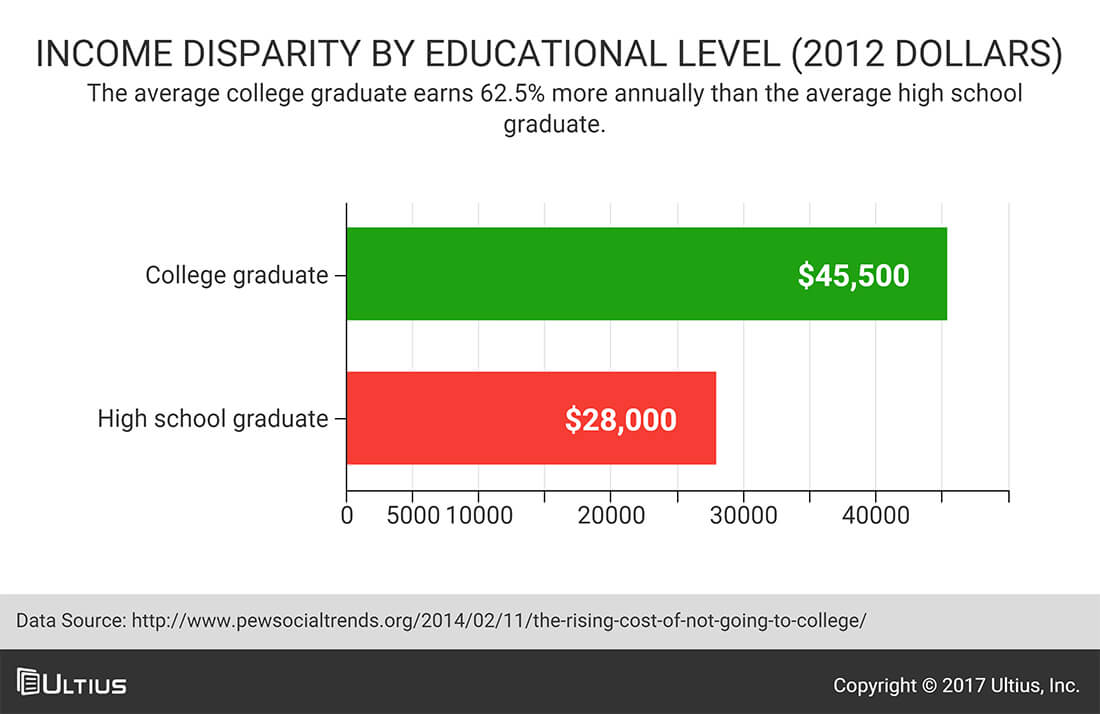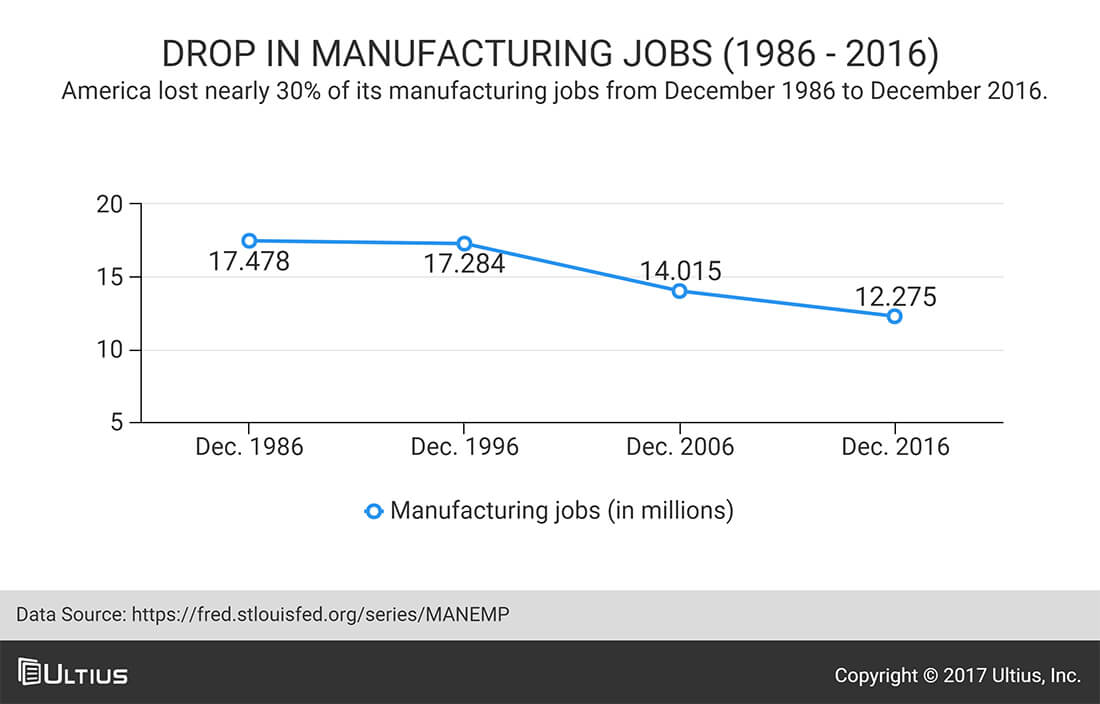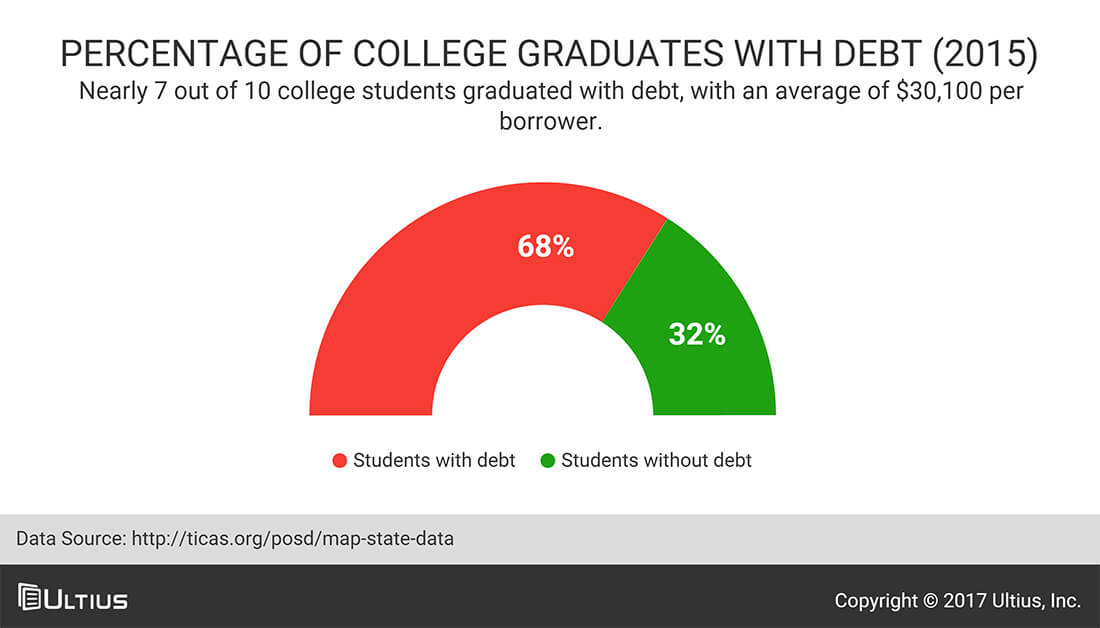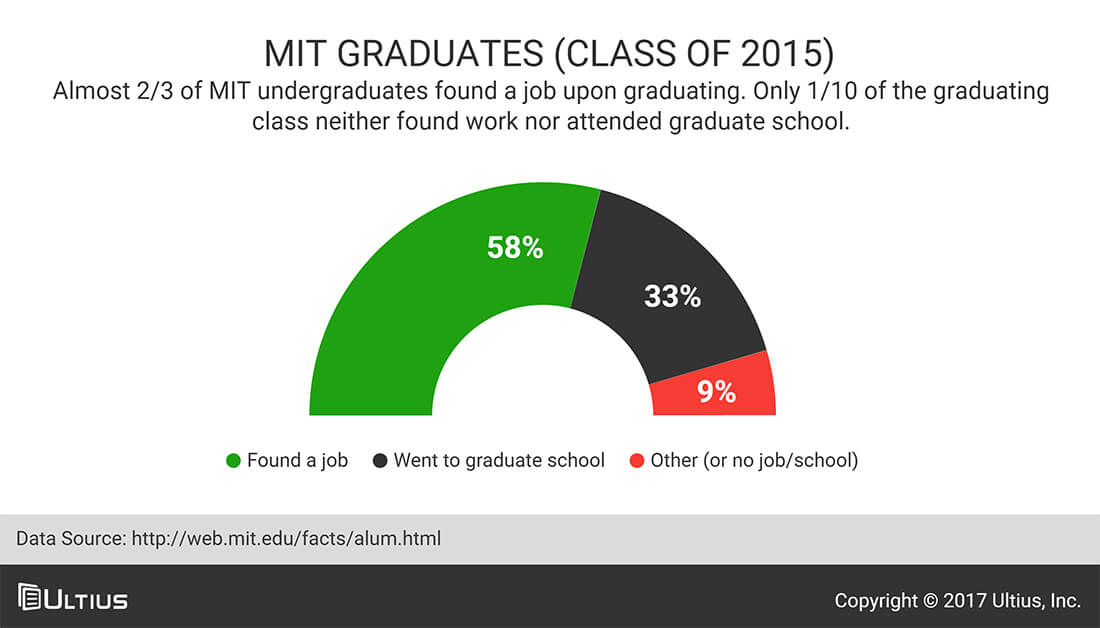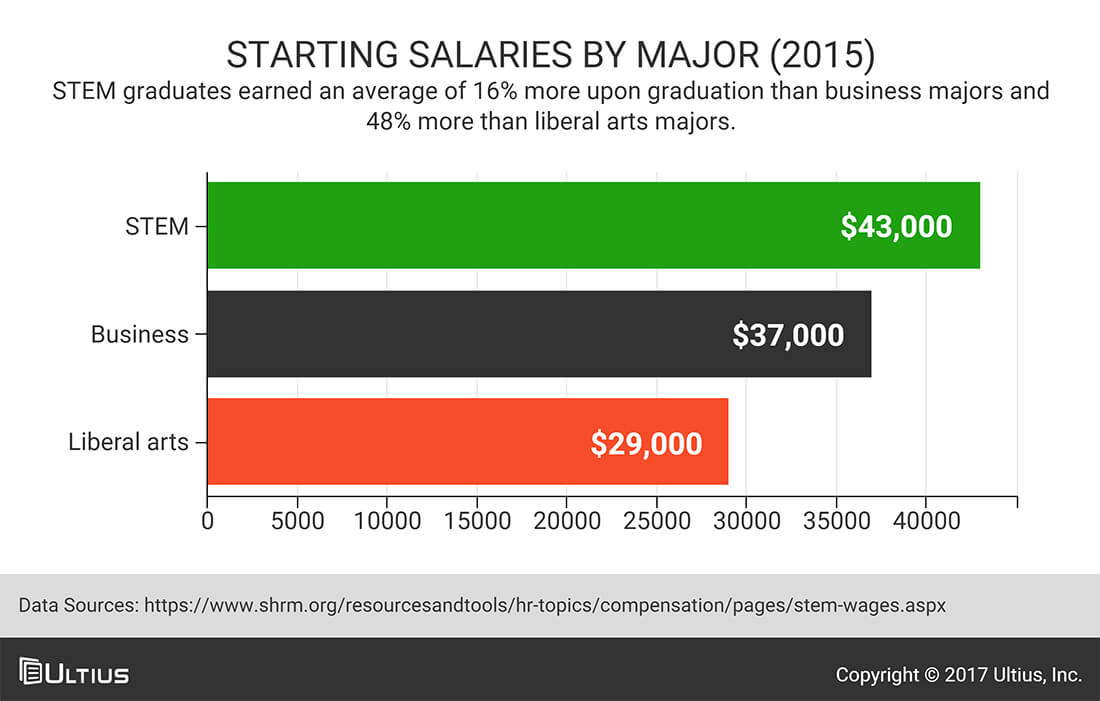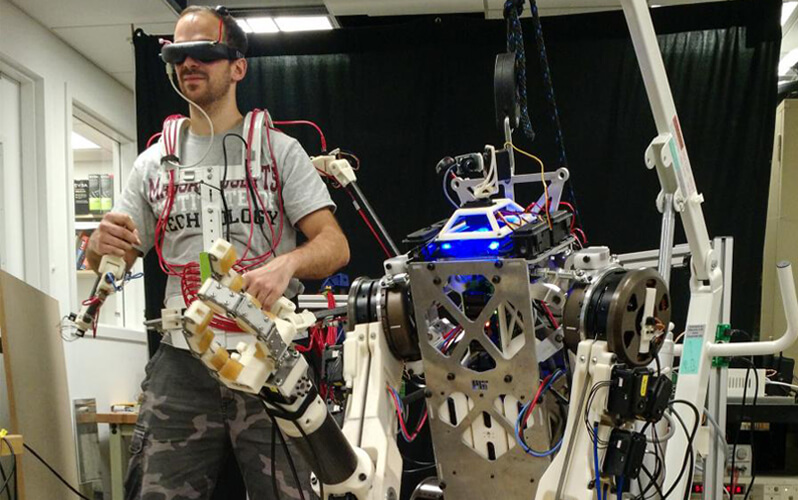Ultius Blog
Graduates of These 10 Colleges Earn the Biggest Paychecks
One of the main reasons that anyone wants to go to college after high school is to improve their economic prospects. It is commonly accepted in today's society that if you have a college education, you will have a much better chance of having a successful and well-paying career over the course of your life, than if you do not have such an education. One important question to consider is: what are the top colleges, in terms of the size of the paycheck you can expect to earn upon graduation?
This article (also an example of an in-depth expository essay) will explore this question for you; more specifically, it will develop and discuss a list of the top 10 colleges in terms of paycheck size upon graduation. The article will focus on four-year bachelor's degree programs, and it will include the following parts:
- background information
- the top 10 colleges
- reasons for success
- track record examples
- the impact of your major
- specific programs at schools
- campus life at the schools
- other considerations
While a top college could be defined by other metrics such as location or cost, by the end of this article, you should have a good idea about what the top colleges are in terms of annual income earned by alumni.
Work in America is changing
When you get out of college, it’s time to get a rewarding job. It is a general fact of today's economy that people with a bachelor's degree are likely to make significantly more money than people with only a high school education. According to the Pew Research Center, for example, for Millennials between the ages of 25 and 32, the average college graduate makes about 1.63 times more money than the average person who only has a high school degree alone.
It is thus an objective fact, even in these times of economic recovery and/or uncertainty, that one of the main purposes of a college degree is to deliver economic value and increase the earning potential of its holder.
The decline of manufacturing in America
Another key theme in contemporary society consists of a change in the economic structure of things, which has resulted in a bachelor's degree becoming perhaps more essential to success than it ever was before. This is because in the past, the manufacturing sector (e.g. "blue collar" work) provided Americans without higher education relatively stable and secure career paths to pursue.
America used to be a manufacturing powerhouse, but now, a large part of the world’s manufacturing jobs are found in China. In the United States, most good jobs require the kind of training and skill sets that are part of a college education.
The relevant statistics from the U.S. Bureau of Labor Statistics indicate that the number of manufacturing jobs in the country has plummeted over the course of the past couple decades.
That's over 5 million jobs that have been lost over the course of the past 30 years. Interestingly, the evidence would seem to also indicate that despite the amount of manufacturing being done in China, most of these jobs have not been lost to globalization. Instead, the loss of millions of manufacturing jobs is due to automation, or jobs being taken over by machines.
Andrew McAfee of Harvard Business Review has indicated that this rise of automation is an important global trend in today's world. This probably means that the jobs that have been lost are not going to be coming back. And that in turn implies that getting a college degree is possibly more important today than ever before. And that in turn implies that getting into college and earning a degree is possibly more important today than ever before.
The problem of college debt
Finally, it is worth noting that college debt has become a major problem for today's generation—which means that finding a high-paying job upon graduation from a bachelor's program has become that much more important. According to the Institute for College Access & Success, in the year 2015, a total of 68 percent of seniors graduating from college had student debt, and the debt that they had amounted to an average $30,100 per student (though perhaps some of the debt may be forgiven).
Such levels of debt mean that it is now important for all college students to consider the payoff of getting a college degree, or whether their degree will enable them to find a job upon graduation that will allow them to pay off their debt and other expenses in an effective way.
Related infographic: Debunk six myths about student financial aid.
The top 10 colleges for earning the biggest paychecks
With all that being said, it is now time to discuss the top 10 colleges in the country, in terms of the paycheck that you can expect to earn upon graduation with a bachelor's degree. Payscale has conducted a study on this subject and reporting the following for four-year undergraduate programs. This list is based on a cumulative assessment including multiple factors, including pay at the beginning of one's career.
| Rank | College | Average starting pay |
| 1 | SUNY Maritime College | $69,700 |
| 2 | Massachusetts Institute of Technology (MIT) | $78,300 |
| 3 | Harvey Mudd College | $78,500 |
| 4 | Princeton University | $65,700 |
| 5 | Stanford University | $70,800 |
| 6 | University of Pennsylvania | $62,200 |
| 7 | Harvard University | $65,200 |
| 8 | Babson College | $59,500 |
| 9 | Santa Clara University | $61,900 |
| 10 | Carnegie Mellon University | $69,400 |
Again, this list is based not solely on starting pay, but also on mid-career pay, as well as the percentage of graduates who report that they have found jobs that give them a sense of meaning. The information regarding starting pay is specifically included in the table above, though, because this may especially relevant when you are making a college decision.
Why military schools are excluded from this list
The table above has been modified a little from the original list provided by Payscale itself. This is because in the original list, the top 10 includes 3 military schools: the United States Military Academy (at West Point), the United States Naval Academy, and the United States Air Force Academy. These are ranked 6, 7, and 8 in the original list.
| Academy | Average starting pay |
| United States Military Academy | $76,000 |
| United States Naval Academy | $72,900 |
| United States Air Force Academy | $68,800 |
These are the starting pay rates for graduates of these schools who do not join the armed forces—which suggests that employers in several sectors may place a premium value on candidates who have military training behind them.
However, these schools have been excluded from the present article's list, due to the fact that as the United States Military Academy Association of Graduates has noted, most students who choose these schools are in fact considering a career in the military. This is different from the general college experience and prospects being sought by most students.
Why graduates of the top 10 colleges earn the most money
One of the main reasons that the top 10 colleges have made it onto this list is that they tend to have a high percentage of graduates from STEM programs. This is a point that needs to be discussed in greater depth.
What is STEM?
STEM is an acronym that stands for Science, Technology, Engineering, and Mathematics. In this sense, a STEM degree could be meaningfully contrasted against a liberal arts or humanities degree. According to an article published by Rodger W. Bybee in the journal Technology and Engineering Teacher, STEM
"had its origins in the National Science Foundation (NSF) and has been used as a generic label for any event, policy, program, or practice that involves one or more of the STEM disciplines."
The advancement of STEM education is one of the main educational priorities within America today, due to the fact that many valuable emerging jobs within the contemporary economy require competence with the STEM disciplines.
The specific effects of a STEM education on your career path will be discussed a little later on in this article. For the time being, it is simply worth noting that most of the top 10 colleges listed above have strong graduation rates in STEM programs.
| Rank | College | Percentage of STEM graduates |
| 1 | SUNY—Maritime College | 47% |
| 2 | Massachusetts Institute of Tech (MIT) | 87% |
| 3 | Harvey Mudd College | 91 |
| 4 | Princeton University | 39% |
| 5 | Stanford University | 43% |
| 6 | University of Pennsylvania | 25% |
| 7 | Harvard University | 35% |
| 8 | Babson College | 0 |
| 9 | Santa Clara University | 27% |
| 10 | Carnegie Mellon University | 54% |
There is thus a strong correlation between being on this list and having a high percentage of STEM graduates.
Other factors in earnings after you graduate
You may notice that Babson College is an anomaly on the list: it has absolutely no STEM graduates at all. But this is because Babson is specifically a business school, and offers nothing but business programs. Going into business with a degree from a strong college could also clearly enable you to make a good amount of money after graduation as the economy becomes more knowledge-based.
On the other hand, there are some colleges you may not have heard much about—such as Harvey Mudd College—that are high on the list because the vast majority of their graduates have STEM degrees.
It is also worth noting that there are three Ivy League schools on this list: Princeton University, the University of Pennsylvania, and Harvard University. Harvard also has a relatively low STEM rate—but then, Harvard also of course has a prestigious business school.
The issue of nepotism in college
Moreover, it is worth observing that the Ivy League schools tend to give students other kinds of advantages, such as making powerful connections and in general plugging into the social networks available at those schools. Considered in an uncharitable way, this could be understood as the problem of nepotism.
Important definition: nepotism—succeeding in society not because of one's inherent skills, but rather because of social networks and who one knows.
The Economist has indicated that nepotism is in fact a very real reason why the Ivy League schools are so prestigious, and why students are often able to land good jobs after graduation from them. However, there may be nothing morally wrong, in principle, with the simple social fact that one has more opportunities if one knows powerful people. In a way, this is the way the world has always worked, and there may ultimately little sense in getting too upset about it.
Worried about your college application? Ultius can help with your admissions essay.
Illustrious alumni and their track record of success
The Ivy League schools—which, again, are featured prominently in the current list of top 10 schools—have a solid track record of producing highly successful alumni. For example, several American presidents have in fact been alumni of Ivy League schools.
| President | Alma mater |
| Barack Obama | Columbia, Harvard |
| George W. Bush | Yale, Harvard |
| Bill Clinton | Yale |
| George H. W. Bush | Yale |
| Gerald Ford | Yale |
| John F. Kennedy | Harvard |
| Franklin D. Roosevelt | Columbia |
| Woodrow Wilson | Princeton |
| William Howard Taft | Yale |
| Theodore Roosevelt | Harvard |
| Rutherford B. Hayes | Harvard |
| William Henry Harrison | University of Pennsylvania |
| John Quincy Adams | Harvard |
| James Madison | Princeton |
| John Adams | Harvard |
Now, here is a list of notable alumni from each of the top 10 colleges identified by Payscale in the organization's list.
| College | Notable alumnus | Profession |
| SUNY Maritime College | John W. Anderson | Sailor |
| Massachusetts Institute of Technology (MIT) | Kofi Annan | Diplomat |
| Princeton University | Woodrow Wilson | Politician |
| Stanford University | Ted Koppel | Journalist |
| University of Pennsylvania | Donald Trump | Businessman, politician |
| Harvard University | Barack Obama | Politician |
| Babson College | Edsel Ford II | Businessman |
| Santa Clara University | Robert Burton | Actor, writer |
| Carnegie Mellon University | Frederick Rossini | Scientist |
While some of these names may not be immediately recognizable to you, all of these people were highly successful and reached the pinnacles of their own chosen professions. Moreover, they did so across a wide range of different lines of works.
A caveat to the above
Fame may not be the best criterion to use when analyzing this list of top 10 colleges. After all, the list has been developed in terms of highest salary upon graduation, which may or may not correspond to achieving fame per se. Many engineers, for example, may not get to a place in their careers where their names are known to the whole world; but they can nevertheless expect to make comfortable salaries with income levels in the middle class over the course of their profession.
An example of alumni success
For example, according to the Massachusetts Institute of Technology (MIT), only nine percent of its undergraduate class of 2015 failed to either find work upon graduation or proceed to a graduate program.
This is a very good alumni profile; and the profiles for many of the other colleges on the top 10 list of this article look similar. These colleges are thus on this list not just because they produce famous people, but rather because they provide good career prospects for the vast majorities of their general student bodies.
The impact of your major on earnings after graduation
How majoring in a STEM discipline impacts earnings after graduation
There is a strong positive correlation between receiving a STEM education and a higher salary. There are a lot of interesting fields included in STEM majors. According to data reported by Stephen Miller of the Society for Human Resource Management, it was found in the year 2015 that STEM graduates earned an average of $43,000/year, whereas business graduates earned $37,000/year and liberal arts majors earned $29,000/year, when evaluated using the same method.
This clearly shows that STEM and business majors on average set one up for making considerably more money than a liberal arts major. As a matter of fact, the data suggests that on average, a graduate with a STEM major makes about 1.48 times more money than a graduate with a liberal arts major. This helps explain for several of the schools on the top 10 list for salaries upon graduation have a high proportion of STEM graduates.
What's wrong with the liberal arts?
This is not to suggest that the liberal arts inherently lack value; rather, it merely implies that the value of the liberal arts may not always correspond to value as it is recognized within the current economic system. It is clearly a fact, that great artists produce very real value for the human species, but it is also a common trope that many such artists live and die broke. The numbers above thus suggest not that the liberal arts have no value but rather that there is a discrepancy going on between two different kinds of value.
From a strictly economic perspective, value is determined by the laws of supply and demand. So, this means that if STEM degrees tend to pay more, then this is because there's a greater demand for STEM-related work in today's economy than there is for other forms of work. Likewise, if liberal arts degrees pay less, then this is because there is a lesser demand for work in this area.
Obama's comment on liberal arts
This is similar to what former President Obama meant when he seemed to speak disparagingly about trying to get an art history degree. These are his words on this matter, as reported by Scott Jaschik of Insider Higher Ed magazine:
"A lot of young people no longer see the trades and skilled manufacturing as a viable career. But I promise you, folks can make a lot more, potentially, with skilled manufacturing or the trades than they might with an art history degree."
This comment made a lot of people rather upset; but Obama's basic point here was related to the laws of supply and demand. He was merely suggesting that given the economy as it stands right now, there may be limited demand in the workplace for a liberal arts graduate with (say) an art history degree, no matter what the intrinsic value of knowledge of art history may or may not be.
Another look at the numbers
It may also be the case that in general, the low salary grade associated with a liberal arts degree may be a relatively temporary phenomenon that tends to diminish as time passes. According to a report published by the Association of American Colleges & Universities, if the frame of reference is expanded to cover an entire career arc, then liberal arts graduates often end up making as much as or even more than STEM graduates.
This would seem to be because even if the liberal arts degree may not directly be associated with any particular professional niche, a liberal arts education still provides the student with a general analytical skill set that can serve him well across a wide range of situations. It may take more time for such a student to find his niche, but he will still have the skill set needed to continually engage in that pursuit.
Nevertheless, it remains true that STEM and business majors tend to have an easier time finding a career track immediately after graduating. On the other hand, everyone has by now heard of the figure of the liberal arts graduate who attended one of the “coolest colleges” in the country, but then goes on to work as a barista.
Key programs at the top 10 colleges for earning the biggest paychecks
Each of the top 10 colleges identified by PayScale are known for particular programs that they offer to their students.
| College | Key program offered |
| SUNY—Maritime College | Marine engineering |
| Massachusetts Institute of Tech (MIT) | Robotics |
| Harvey Mudd College | Engineering |
| Princeton University | Politics |
| Stanford University | Medicine |
| University of Pennsylvania | Accounting |
| Harvard University | Business |
| Babson College | Business |
| Santa Clara University | Bioengineering |
| Carnegie Mellon University | Engineering |
Of course, several of these schools are large universities that often a full array of programs for undergraduates, which means that the programs cited in the chart above are only examples. It is only Babson College, which is exclusively a business school, and Harvey Mudd College, which is almost exclusively an engineering school, that do not offer the full spectrum of program options for their student bodies.
An important reminder
Again, it must be noted here that diversity of programs, just like famous alumni, was not the basis of why the list was developed. Rather, the only point is that students from the selected top 10 colleges tend to make the most money upon graduation from those colleges. And moreover, this is based primarily not on program diversity but rather on the high number of students at these schools who opt to pursue a STEM or business degree. This is the primary variable that has affected the rankings.
Campus life at the top 10 colleges
Campus life at the top 10 colleges can vary significantly, given the fact that all 10 colleges may not have a great deal in common with each other, aside from producing graduates who bring in substantial paychecks. In this context, it may be worth considering the cases of three specific colleges from the list: Princeton, Babson, and MIT.
Case 1: Princeton
Princeton is a full university that offers a diverse array of programs to its students, and has other residential colleges named after notable alumni, such as Walt Whitman. According to Princeton itself:
"First- and second-year students live in one of the University's six residential colleges: Butler, Forbes, Mathey, Rockefeller, Whitman, or Wilson."
Princeton thus strongly values creating a strong student culture of solidarity and identification with the university. As long as a student is at Princeton, being a part of the Princeton community may well become the most important part of his identity; and this may continue well into his professional life as well. It perhaps also helps that the student body of Princeton is generally composed of just over 5,000 students.
This dovetails with the consideration of nepotism described above, and how it may not be problematic per se. The fact is that many students at Princeton may come from wealthy and/or powerful families, and that Princeton is explicitly organized to create a sense of Princeton identity in its students. This results in a strong community that may be able to advance its members within the context of society and the outside world.
Case 2: Babson College
Babson is located in Massachusetts, and it offers on-campus housing options to all of its students. The college is considerably smaller than Princeton, with a student body of just over 2,000. You may not have really heard of Babson college before, and the institution clearly has less prestige than a place like Princeton.
However, Babson probably tends to cultivate solidarity and identity among its students by the simple fact that they all have a single shared interest: Babson is exclusively a business school. This is primarily why Babson has made it onto the current top 10 list.
Case 3: MIT
MIT also stresses the value of community on campus, and it has a strong on-campus housing program. The undergraduate enrollment at MIT is about 4,500. MIT provides students with strong internship program opportunities, and almost nine in ten of the students at MIT are in pursuit of a STEM degree. Robotics, specifically is an attractive course for a lot of students.
This means that MIT students can take advantage of campus connections, experience work in their chosen fields before graduation, and graduate from a degree from a prestigious university, in a field in which workers are in high demand. This is a veritable recipe for success. The student body prides itself on technology, and is listed in a previous blog by Ultius as one of the “nerdiest colleges” in America.
Other factors to consider
On the basis of the above discussion, one additional point that should be considered here is that the colleges on the top 10 list generally tend to be on the smaller side, which may have skewed the reported results. A smaller, more concentrated college may actually end up producing fewer high-earning graduates than a larger institution, but still achieve a higher rate of such graduates.
For example, the undergraduate student body of Princeton consists of about 5,000 students, whereas the undergraduate student body of the University of Texas at Austin consists of about 50,000 students—ten times as much. So, if UT produced high-earning graduates at even a 30 percent rate, that would amount to three times as many high-earning graduates as if Princeton produced them at a 100 percent rate.
| University of Texas at Austin | ||
| Student body | Percent of student body with high earning potential | Total number of high-earners |
| 50,000 | 30% | 15,000 |
| Princeton University | ||
| Student body | Percent of student body with high earning potential | Total number of high-earners |
| 5,000 | 100% | 5,000 |
In short, the top 10 ranking is based on the rate of successful graduate production for each college, and not absolute numbers of successful graduates produced.
A note on following your heart and earnings after graduation
Finally, it is perhaps worth noting here that there is more to life than money, and you probably should not go into a program you'll hate just because it promises to bring you a large paycheck. Rigorous schools aren’t for everyone. There are those who attend college because of the social or party experience, rather than the focus on academics. The fact of the matter is that most people who are highly successful in their fields not only chose their field for the money but also actually love the work they are doing. They have not only extrinsic motivation but also intrinsic motivation for pursuing success.
So, if you have your heart set on a liberal arts degree, then you should probably not let the information above deter you from this track. The world does in fact need art. There surely are specific challenges inherent in the relationship between a liberal arts degree on one hand and the nature of the current economy on the other; but all the same, the point still stands that you will still have a good chance of meeting with success if you stay passionate and committed in your choices.
Key factors in earning potential for graduates of the top 10 colleges
This article has consisted of a discussion and analysis of the top 10 colleges in terms of the paycheck you can expect to receive after graduating from the school. The article began with a general discussion of the value of a college education in these times, and then it proceeded to delve into the top 10 colleges themselves (excluding the military schools, given that these will likely only satisfy a small niche of students).
A key conclusion that has emerged here is that the top 10 list has been conditioned by two factors:
- Many of the colleges on the list are quite small, in terms of student body size.
- Many of the colleges on the list produce a high number of STEM and business graduates.
The small student body size means that the colleges produce not necessarily a high number of successful graduates, but rather just achieve a high rate of success. And the major choices of students are the primary reason why these specific colleges are on the top 10 list.
We hope this information has been helpful to you as you go about making your own decisions about your own academic future and has served as a good example of what you can expect when buy an essay from Ultius.
Works Cited
Association of American Colleges & Universities. "Liberal Arts Degrees and Their Value in the Employment Market." Author, 2013. Web. 31 Jan. 2017. <http://www.aacu.org/nchems-report>.
Bybee, Rodger W. "Advancing Stem Education: A 2020 Vision." Technology and Engineering Teacher 70.1 (2010): 30-35. Print.
The Economist. "The Curse of Nepotism." Author, 8 Jan. 2004. Web. 30 Jan 2017.
<http://www.economist.com/node/2333345>.
Jaschik, Scott. "Obama vs. Art History." Insider Higher Ed. 31 Jan. 2014. Web. 31 Jan. 2017.
<https://www.insidehighered.com/news/2014/01/31/obama-becomes-latest-politician-criticize-liberal-arts-discipline>.
Klebnikov, Sergei. "Liberal Arts vs. STEM: The Right Degrees, the Wrong Debates." Forbes. 19 Jun. 2015. Web. 30 Jan. 2017. <http://www.forbes.com/sites/sergeiklebnikov/2015/06/19/liberal-arts-vs-stem-the-right-degrees-the-wrong-debate/3/#7f6b97ed53f5>.
Massachusetts Institute of Technology. "MIT Students after Graduation." Author, 2015. Web. 30 Jan. 2017.
<http://web.mit.edu/facts/alum.html>.
McAfee, Andrew. "Manufacturing Jobs and the Rise of the Machines." Harvard Business Review. 29 Jan. 2013. Web. 21 Jan. 2017. <https://hbr.org/2013/01/manufacturing-jobs-and-the-ris>.
Miller, Stephen. "STEM Graduates' Salaries Exceed Others, but Face Slow Down." Society for Human Resource Management, 11 May 2015. Web. 30 Jan. 2017. <https://www.shrm.org/resourcesandtools/hr-topics/compensation/pages/stem-wages.aspx>.
PayScale. "Best Universities and Colleges by Salary Potential." Author, 2016. Web. 21 Jan. 2017.
<http://www.payscale.com/college-salary-report/bachelors?page=2>.
Pew Research Center. "The Rising Cost of Not Going to College." Author, 11 Feb. 2014. Web. 21 Jan. 2017.
<http://www.pewsocialtrends.org/2014/02/11/the-rising-cost-of-not-going-to-college/>.
Princeton University. "Campus Life: A Princeton Profile." Author, 2017. Web. 31 Jan. 2017.
<http://www.princeton.edu/pub/profile/campus-life/>.
United States Military Academy Association of Graduates. "Retention of USMA Graduates on Active Duty." Author, n.d. Web. 21 Jan. 2017.
<http://www.west-point.org/publications/retention-whitepaper/RetentionPaperRev3.pdf>.
- MLA Style
- APA Style
- Chicago Style
- Turabian
Ultius, Inc. "Graduates of These 10 Colleges Earn the Biggest Paychecks." Ultius | Custom Writing and Editing Services. Ultius Blog, 08 Mar. 2017. https://www.ultius.com/ultius-blog/entry/graduates-of-these-10-colleges-earn-the-biggest-paychecks.html
Copied to clipboard
Click here for more help with MLA citations.
Ultius, Inc. (2017, March 08). Graduates of These 10 Colleges Earn the Biggest Paychecks. Retrieved from Ultius | Custom Writing and Editing Services, https://www.ultius.com/ultius-blog/entry/graduates-of-these-10-colleges-earn-the-biggest-paychecks.html
Copied to clipboard
Click here for more help with APA citations.
Ultius, Inc. "Graduates of These 10 Colleges Earn the Biggest Paychecks." Ultius | Custom Writing and Editing Services. March 08, 2017 https://www.ultius.com/ultius-blog/entry/graduates-of-these-10-colleges-earn-the-biggest-paychecks.html.
Copied to clipboard
Click here for more help with CMS citations.
Ultius, Inc. "Graduates of These 10 Colleges Earn the Biggest Paychecks." Ultius | Custom Writing and Editing Services. March 08, 2017 https://www.ultius.com/ultius-blog/entry/graduates-of-these-10-colleges-earn-the-biggest-paychecks.html.
Copied to clipboard
Click here for more help with Turabian citations.

